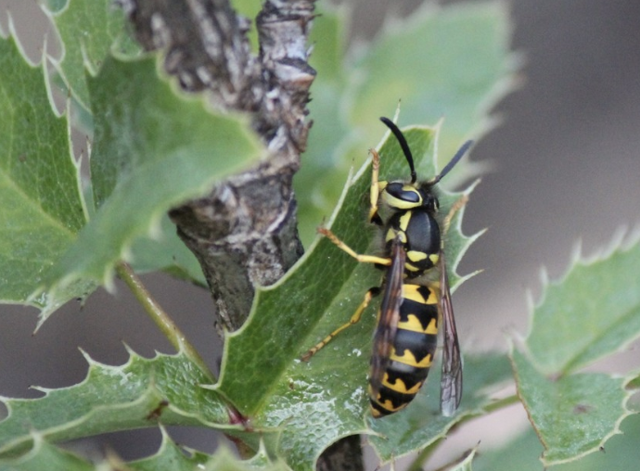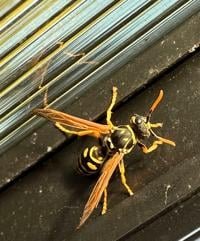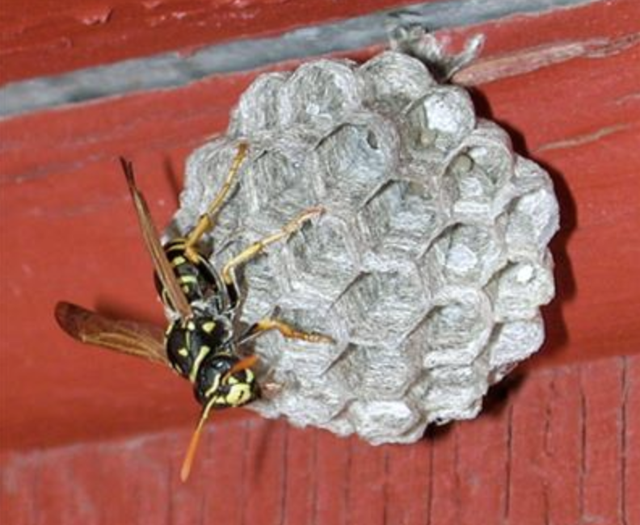Timing is everything when controlling invasive paper wasps
By Julie Banken
WSU Chelan/Douglas County Master Gardener




Vespid wasps don’t often make it onto anyone’s list of favorite insects. Like fighter jets on a mission, they fly with purpose, and their bold aposematic colors warn that getting too close could result in a painful sting. Although they provide helpful pollination and pest-control services, they are intimidating, even to this Master Gardener.
I considered my own prejudice while I watched a large yellow and black wasp land on the doorframe of our greenhouse. With long legs dangling in flight, a narrow waist and orange-tipped antennae, it wasn’t hard to identify it as a European paper wasp.
European paper wasps look a lot like their aggressive cousins, the yellowjackets. Yellowjackets are the wasps that will ride a ham sandwich into your mouth or fly into an open can of pop just before you take a drink. Normally they feed on insects and flower nectar, but when supplies run low, they scavenge for protein and sugar wherever they can find it. Because they tend to build their nests underground, they seem to appear from out of nowhere at a picnic. Their demand for food becomes acute in the fall, when colonies can number several thousand individuals.
Like an evil twin, yellowjackets cause a lot of grief and frustration, leaving paper wasps to take the blame. European paper wasps need protein and sugar, too, but they are not scavengers and are not interested in people food. They prey on a variety of soft-bodied insects, and gather sugar from flower nectar, pollinating as they go. Colonies usually have fewer than 100 individuals at season’s end, and as long as you don’t disturb their nests, they won’t bother people.
It would be easy to co-exist with European paper wasps if they didn’t build their papery, umbrella-shaped nests in very inconvenient places. Look for them on swing sets, fences, chicken coops, RVs and boats, inside birdhouses, under the barbecue lid and in shrubs that need trimming, such as arborvitae. They also like greenhouses. Last summer, there were so many in my yard that it was difficult to avoid disturbing them.
European paper wasps are a mixed blessing. Even though they pollinate flowers and provide gardeners with natural pest control, these invasive newcomers are so successful that they are outcompeting native species. It makes sense to discourage them from building nests, especially around the home.
When it comes to reducing insect populations, timing is everything. Remove wasp nests early when they are small and have only one queen to protect them. In the spring, queens work alone and must leave their nests to gather food and nest-making material. In another month when the first generation of workers matures, nests will not be left undefended. Colonies will grow quickly and removing them will be more difficult.
To remove paper wasp nests, spray them with a jet of water from a safe distance. Alternatively, wait until the queen is out foraging, then quickly slide nests into a plastic container that can be covered with a lid. Queens will start rebuilding, but if you continue to disrupt them, eventually they will give up and go elsewhere.
Yellowjacket traps will do nothing to deter European paper wasps. While treating their nests with powerful insecticides might be tempting, doing so can invite more problems. Chemicals may kill adults but not affect developing pupae, making them ultimately ineffective. They also will contaminate the area with long-lasting toxins. To top it off, birds and insects that prey on treated larvae or pupae will inadvertently be exposed. Better is to remove wasp nests to slow their reproduction, then let their predators go to work.
A WSU Chelan and Douglas County Master Gardener column appears weekly in The Wenatchee World. To learn more, visit bit.ly/MGchelandouglas or call (509) 667-6540.
